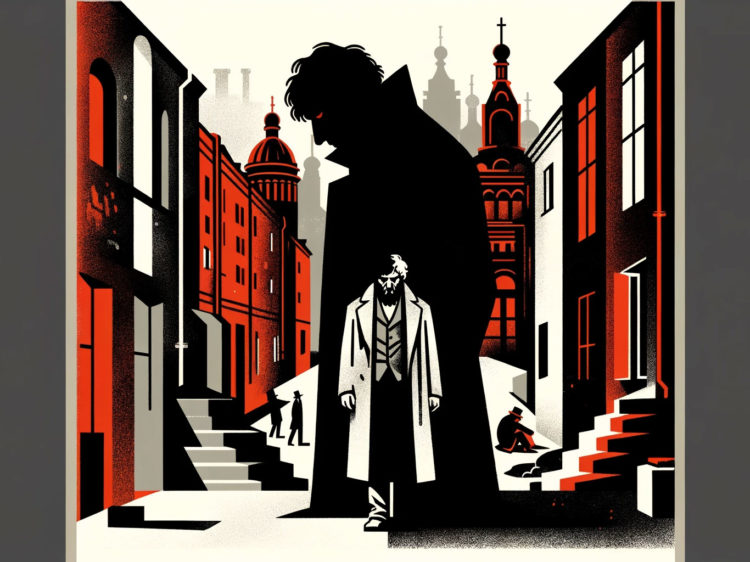Summary of “Crime and Punishment”, a novel by the Russian author Fyodor Dostoevsky, first published in 1866. The central character, Rodion Raskolnikov, is a former student living in poverty in St. Petersburg. He believes himself to be an extraordinary person who is entitled to commit crimes if the outcome will benefit humanity. The novel delves deeply into themes such as the nature of good and evil, the morality of crime, and the possibility of redemption. It is considered one of Dostoevsky’s greatest works and a landmark in world literature.
Short Summary of The Novel
Rodion Raskolnikov, an impoverished ex-student in St. Petersburg, formulates a plan to kill a dishonest pawnbroker for her money. After murdering her and her sister who stumbles upon the crime, he becomes wracked with guilt and paranoia. Despite successfully executing the crime, he struggles to escape the consequences of his actions.
Raskolnikov’s mental anguish leads him through a series of intense interactions with friends, family, and others who inadvertently draw him into a web of suspicion. Sonia, a downtrodden prostitute, becomes his confidante and spiritual guide. As he teeters on the brink of a nervous breakdown, the cat-and-mouse game with the investigating officer, Porfiry Petrovich, intensifies.
The pressure mounts until Raskolnikov confesses to Sonia. Her love and compassion lead him to eventually confess to the authorities. The novel concludes with Raskolnikov sentenced to Siberia, where Sonia follows him, offering a chance for atonement and spiritual rebirth.
Comprehensive Plot Summary of “Crime and Punishment”
Part One: The Plan and the Murder
Rodion Raskolnikov, an impoverished former law student in St. Petersburg, meticulously plans the murder of a pawnbroker, Alyona Ivanovna, believing he can liberate himself and others from suffering with her money. He also rationalizes that his intellectual superiority justifies the crime. Raskolnikov executes his plan, killing both the pawnbroker and her sister, Lizaveta, who unexpectedly enters the scene.
Part Two: The Aftermath
Haunted by his actions, Raskolnikov exhibits erratic behavior, arousing suspicion. He visits the police station for unrelated business but overhears conversation about the murders, which causes him to faint, further increasing police suspicion. He also contemplates turning himself in but ultimately decides against it.
Part Three: Mire of Guilt
Raskolnikov’s mental state deteriorates as he becomes increasingly isolated. He rejects the people who care about him, including his mother and sister, Dunya. His guilt is compounded by the stark poverty around him, particularly in the Marmeladov family, whose daughter, Sonia, is forced into prostitution.
Part Four: Descent into Madness
As the police investigation intensifies, Raskolnikov’s paranoia grows. He toys with confessing and even engages in a cat-and-mouse game with the investigating officer, Porfiry Petrovich. During this time, he becomes more involved with Sonia, who becomes a confidante and spiritual guide.
Part Five: Confession and Justification
Raskolnikov’s internal conflict reaches a climax. He publishes an article in which he explains his theory of the ‘extraordinary man’ who is above the law. Meanwhile, an innocent man, Nikolai, confesses to the murders, providing Raskolnikov with temporary relief. However, his conscience and Sonia’s influence lead him to confess to the police.
Part Six: Punishment
Raskolnikov is sentenced to eight years of hard labor in Siberia. Initially, he remains aloof and unrepentant, treating his punishment as an intellectual challenge. However, the harsh realities of penal servitude begin to erode his defiance.
Epilogue: Redemption
In Siberia, Raskolnikov remains emotionally detached until an illness brings him to the brink of death. In his recovery, he has a profound realization about the value of life and human connection, largely influenced by Sonia’s unwavering support. He finally accepts his guilt and the need for moral redemption, ending the novel on a note of tentative hope for his spiritual rebirth.
Interesting Facts
- Author’s Reflection: Dostoevsky drew from his own experiences in a Siberian prison camp when writing “Crime and Punishment.” His firsthand knowledge of life among the very poor adds a layer of authenticity to the novel.
- Original Language: The novel was written in Russian and is lauded for its original expressive language and narrative techniques, which have posed challenges for translation into other languages.
- Psychological Depth: “Crime and Punishment” is considered one of the first and finest examples of psychological fiction. It delves deeply into the mind of its protagonist, Raskolnikov, a feature that was groundbreaking at the time of publication.
- Influence on Law and Psychology: The novel has had an impact on both legal and psychological fields, particularly regarding the moral and psychological implications of crime and guilt.
- Philosophical Exploration: Dostoevsky explores Nietzschean philosophy before Nietzsche became well-known. He examines the concept of the “Übermensch” or “superman” through Raskolnikov’s character, who believes some people are naturally entitled to bypass laws for the greater good.
- Title’s Meaning: “Crime and Punishment” originally has a different title in Russian, “Преступление и наказание” (Prestupleniye i nakazaniye), which can be directly translated as “crime” and “penalty.” The nuanced difference in “punishment” emphasizes the moral and psychological aspects over the legal ones.
- Serialized Publication: Like many novels of its time, “Crime and Punishment” was initially published in a literary journal called “The Russian Messenger” in a serialized format in 1866.
- Real Crime Inspiration: The plot was inspired by a real case Dostoevsky learned about during his time at the prison camp: a man who murdered an old woman.
- Financial Motivation: Dostoevsky was in dire financial straits due to his gambling addiction when he wrote the novel, which may have influenced the theme of desperation leading to crime.
- Cultural Impact: The novel has deeply influenced global literature and culture, inspiring numerous adaptations, including films, television shows, theater productions, and even operas.
- Existentialist Themes: “Crime and Punishment” is often cited as a precursor to existentialist thought in literature, focusing on individual existence, freedom, and choice.
Frequently Asked Questions About “Crime and Punishment”
What drives Raskolnikov to commit murder?
Raskolnikov is driven to commit murder partly by his dire financial situation and his belief in a theory that some people possess the innate right to disregard laws if it means they can contribute something extraordinary to society. He sees himself as one such “extraordinary” person and the pawnbroker as a worthless leech.
What is the significance of the character Sonya in the novel?
Sonya Marmeladov, a prostitute with a heart of gold, represents compassion, self-sacrifice, and Christian redemption. Her influence and spiritual guidance are pivotal in Raskolnikov’s eventual confession and moral reconciliation.
How does “Crime and Punishment” explore the theme of redemption?
The theme of redemption is central to the novel, with the protagonist’s journey from crime to punishment serving as a pathway to his eventual moral and spiritual salvation, influenced heavily by his interactions with Sonya and his own psychological turmoil.
Is “Crime and Punishment” a critique of utilitarian philosophy?
Yes, the novel can be seen as a critique of utilitarian philosophy and radical ideas of the time that justified immoral actions for the “greater good.” Dostoevsky challenges the notion that the end always justifies the means through Raskolnikov’s disastrous attempt to live by such principles.
What role does St. Petersburg play in “Crime and Punishment”?
St. Petersburg is more than just a backdrop in the novel; it’s a character in itself. The oppressive atmosphere, crowded tenements, and the stark contrasts between wealth and poverty reflect and amplify the internal conflict of Raskolnikov and other characters.
Does Raskolnikov feel guilty about the murder?
Yes, Raskolnikov experiences intense guilt after the murder, which manifests as paranoia, illness, and a psychological crisis, indicating Dostoevsky’s exploration of the deep impact of guilt on the human psyche.
How does Dostoevsky portray the legal system in the novel?
Dostoevsky portrays the legal system through the investigative process of Porfiry Petrovich, who is both astute and psychologically adept. The system is shown to be less about the mechanics of law and more about the psychological chess game between the investigator and the criminal.
My Personal Review
“Crime and Punishment” shatters the mold of traditional storytelling; it’s a psychological mind-bender that grabs you by the conscience and doesn’t let go. Raskolnikov isn’t just a character; he’s a haunting exploration of ambition and guilt that leaves you questioning your own moral boundaries. Dostoevsky crafts a world where the line between right and wrong blurs, making you complicit in the protagonist’s turmoil.
The novel’s dive into the philosophical depths of existential dread, the thirst for redemption, and the scales of justice is a bold, raw slice of human fragility. It doesn’t just challenge societal norms – it dares to dissect the human condition. “Crime and Punishment” is a defiant roar in the quiet library of literary classics, an unflinching mirror that reflects the complexities of our own natures back at us with a clarity that is as uncomfortable as it is undeniable.
📚👀 Was Dostoevsky a genius or just a madman with a quill? Sound off in the comments! 🤯✍️


Comments